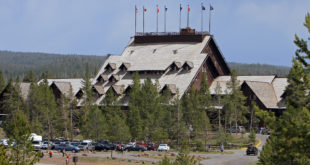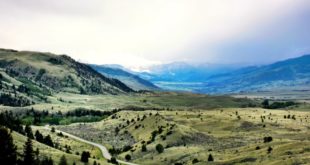Coalition sues federal government over wolf status
WOLVES: An attorney for a coalition of twelve animal rights groups filed suit today in U.S. District Court at Missoula, Montana, seeking an immediate injunction to suspend state management of wolves, pending a final resolution of the case. The groups, reacting to the de-listment of the wolves as an endangered species and the subsequent turn over of wolf management to individual states (in this case Montana, Wyoming, and Idaho), are seeking re-instatement of the endangered status to stop the ‘wanton killing’ of wolves in areas where they are now classified as predators available for ‘shoot-on-sight’.
Park officials defend bison numbers
BISON: Facing a rising uproar over the slaughter of 1700 Yellowstone Park bison this winter – on top of a winter kill of at least 700 – Yellowstone Park officials and their partners in the Interagency Bison Management Plan have stopped the slaughter of bison (with the exception of “some adult bulls”) that are caught heading outside the park boundaries. The official position, according to spokesman Al Nash, is “Our job is to maintain a wild bison population, and we won’t take any action that endangers the population as a whole.”
So far about half of the Yellowstone herd has been killed, with remaining numbers estimated beween 2000 and 2300. The biggest bone of contention, and the most poorly documented, is just what constitutes an appropriate herd size. Although a few scientific papers on the subject exist, they rarely receive public visibility, which means that most arguments are conducted in a relatively factless environment. Not that the science on this issue is conclusive, obviously, or there wouldn’t be so much contention.
Is keeping the Sylvan Pass open in winter worth $4 million?
[Friday April 25, 2008] The stakes were raised in Cody’s fight to keep the Sylvan Pass open in winter after Yellowstone National Park officials reported it would require an investment of $4 million — money the Park is not willing or able to pay.Winter kill adds to the record loss of bison
[Friday April 18, 2008] The other hoof dropped (on a Friday no less) – it was news that on top of the roughly 1700 bison killed by hunters or sent to slaughter this winter, the annual winter kill (bison who don’t survive the rigors of winter) appears to be between 400 and 700, bringing the total loss of the Yellowstone bison to about half the herd. Something like this should have been expected, as a tough winter is the reason so many bison were heading for lower, warmer terrain near the park border.The 2007 herd was estimated at 4700 head; now 1700 are dead by the hand of man, and roughly 500 dead by this point from winter conditions; that equals approximately 2500 head (+/- 200). The figure is still above the cutoff point of 2100 set by the Interagency Bison Management Plan; the point at which non-lethal measures are required to manage the bison. The target bison population is 3000. However, winter isn’t over in Yellowstone, as spring storms, hungry grizzlies, and wolf packs typically take a significant toll at least until June. Whatever the herd population come the end of spring, this winter of 2007-2008 has set a record for the number of bison killed and could be heading for historic lows in the bison population.
Big snow pack means needed water relief
[Friday April 18, 2008] After several years of drought and meager accumulation of snow in the mountains (themountain snow pack), areas throughout the Greater Yellowstone Region are reporting deeper than average snow pack for this time of year. From the Beartooth Mountains in the east, where snow pack at 8,000 feet is above six feet, to the South Entrance of Yellowstone Park, which saw more than 100 inches of snow just in the month of March, the amount of snow still on the ground at mid-April is cause for some celebration.The mountain snow pack acts like a frozen reservoir of water that slowly releases into the streams and rivers of the region during the summer months, providing a supply of water to fish, wildlife, ranchers, and farmers that is less fickle than the summer rains. In recent years that snow pack has been dwindling, right along with the levels in key lakes and reservoirs throughout Wyoming, Montana, and Idaho. This year, however, while hardly a record the depth of snow has come back to previous levels. As Yellowstone National Park spokesman Al Nash put it, “This winter may have had the most snowfall it has seen in seven to ten years.”
[More here.]Moratorium on bison killing requested
[Wednesday April 10, 008] Spurred by the killing of over 1400 bison that were attempting to winter-migrate from Yellowstone National Park (a record number, approximately 1/3 of the northern herd), three groups (The Natural Resources Defense Council, the Gallatin Wildlife Association, and the Buffalo Field Campaign) have written a letter to Montana Governor Brian Schweitzer, Yellowstone National Park officials, and other agencies requesting an immediate moratorium on the killing and slaughter of bison, and that the current agreement for a bison management plan (the Interagency Bison Management Plan) be revisited.Park Service to hold brucellosis risks at Stephens Creek
Most of the winter, the holding pens at Stephens Creek (a few miles northwest of Gardiner, MT) have been the collection point for Yellowstone Park bison that migrated toward the park boundary. From there, most of the bison were shipped to slaughter. Well over 1200 bison were processed from this facility. Now, with the coming of spring and the calving season, the park service is organizing under the IBMP (Interagency Bison Management Plan) to hold pregnant bison in order to prevent them from birthing in areas where it is possible for cattle to come into contact with birth materials – the most likely transmitters of brucellosis.
Closure on a major mining dispute
A non-profit organization, Trust for Public Land, has announced it will purchase for $8 million the last significant remaining privately owned land and mining claims of the “New World Mining District” and re-sell it to the U.S. Forest Service. This will bring closure to one of the hottest Yellowstone controversies of the 1990s.
The historic New World Mining District is located just north of Cooke City, Montana. As the raven roams, the area is less than four miles from the northeast boundary of Yellowstone National Park, and its water drainage flows into the park via Soda Butte Creek. Both of these facts worried conservationists and park officials, who saw a new mining operation in the area as a potential source of serious pollution for Yellowstone Park, and a major disruption for wildlife in the area.
[read more]Over 1,000 of the Yellowstone National Park bison herd killed
There are few things inviting more passionate discussion than the state of the Yellowstone National Park bison. But when the news emerged last week that the National Park Service has culled a quarter of the Yellowstone herds in the name of management, many observers of Yellowstone National Park deemed the slaughter as being abnormally extreme, verging on the cruel and capricious. The numbers are staggering: this winter season 1,192 of the 4,700 Yellowstone National Park bison have been slaughtered, according to AP. That’s a record; the previous high was 1,084 in 1997. We look at the great bison controversy of 2008 and see whether a solution is in sight.
Old Faithful Visitor Education Center news
We now have a date — of sorts, anyway — for the groundbreaking for the new Old Faithful Visitor Education Center at Yellowstone National Park: May.
The 26,000-square-foot building will be built on the former site of the small visitor center located near Old Faithful Inn. The old visitor center wasn’t much — the small lobby held a ranger desk and a Yellowstone Association store, while the concrete (i.e., cheap) building was light years away from the “parkitecture” found in the area — but the replacement should be dazzling. (A rendering of the lobby entrance, courtesy of the National Park Service, is at the end of this article.)
The two-story replacement should be open in 2010. Park officials are expecting 2.6 million visitors per year to tour the new facility. In the meantime, we’ll all need to put up with the cramped temporary quarters and makeshift restrooms until the fall of 2010.
[read more]
 Yellowstone Insider Your Complete Guide to America's First National Park
Yellowstone Insider Your Complete Guide to America's First National Park





